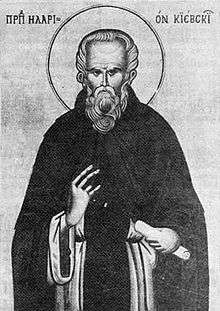Hilarion of Kiev
Hilarion or Ilarion (Russian: Иларион, Ukrainian: Іларіон, Belarusian: Іларыён) was the first non-Greek Metropolitan of Kiev. While there is not much verifiable information regarding Hilarion's biography, there are several aspects of his life which have come to be generally accepted.

According to the Primary Chronicle Hilarion served as a priest or monk in the princely residence of Berestovo (Berestov) near the Rus' capital of Kiev. He acquired the reputation of well-educated scholar and upon the death of Metropolitan Theopemptus in 1049, Hilarion was proclaimed the metropolitan of Kiev by Yaroslav the Wise, the Grand prince of Kiev, who thus challenged the old Byzantine tradition of placing Greeks on the episcopal sees.
Hilarion's appointment met with stiff opposition from Luka Zhidiata, Bishop of Novgorod (r. 1035-1060). Zhidyata openly opposed probably because it was the prerogative of the Patriarch of Constantinople to appoint the Kievan metropolitan and thus Hilarion's appointment was uncanonical. For his opposition, Luka was confined in the Kievan Caves Monastery for three years until his death, at which time his remains were taken back to Novgorod and buried in the Cathedral of Holy Wisdom there.[1]
It appears as though Hilarion did not serve an extended term as the Kievan metropolitan, as some chronicles began mentioning Metropolitan Yefrem in 1055. Nevertheless, Hilarion remains the best known of all the ancient Kievan metropolitans, not only because he was the first native to ascend to that position, but also because of his writings.
Hilarion is credited as the author of four works:
- Sermon on Law and Grace,
- Confession of Faith
- Sermon on Spiritual Benefit to All Christians
- a short collection of instructions for priests called "Слово к брату столпнику" (A word to brother stylites)
References
- ↑ Michael C. Paul, "A Man Chosen By God": The Office of Archbishop in Novgorod, Russia 1165-1478 (PhD Dissertation, University of Miami, 2003).
External links
- Ilarion, Metropolitan in the Encyclopedia of Ukraine
- Hilarion at list of biographies and "ХРОНОС"
- Hilarion, the Metropolitan of Kiev at the Rulex.ru Portal
- Hilarion of Kiev by Alexander Men
- Hilarion, the Metropolitan of Kiev, by Sergey Perevezentsev
- Sermon on Law and Grace by Hilarion with notes and comments by M. Maslin, from the online library of Russian Classics
| Preceded by Theopemptus of Kiev |
Metropolitan of Kiev and All-Rus' 1051–1055 |
Succeeded by Ephraim I of Kiev |